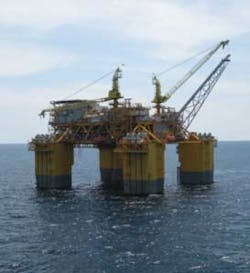DRILLING & PRODUCTION
John Waggoner • Houston
New sidetrack technique proves worthy at Åsgard
StatoilHydro and FMC Technologies have developed new technology to drill sidetracks through existing tubing on subsea fields.
The technique, called “through tubing rotary drilling” enables reuse of old wells in a simpler and cheaper way than previous technology, the developers say. The technology was successfully tested on the Åsgard field in the Norwegian Sea after close to five years of development.
According to Øystein Arvid Håland, head of subsurface technology at StatoilHydro, the drilling operation produced extra oil worth some NOK 1.4 billion ($236 million) based on current prices from the Åsgard field alone.
“The new concept will highly improve the efficiency of this type of operations in connection with subsea well operations, and enables us to produce oil that we would normally not have recovered,” says Håland.
A conventional rig,Stena Don, was used at Åsgard this time, but the result of this technology will be even better on a purpose-built rig.
“In the autumn we plan to invite bids for a rig to be tailored to such operations, and the aim is to get the new rig into place in 2012/2013,” Håland says.
The rig will only contain the equipment needed for this type of operations and will be a brand new type of rig. This new technology may be used in water depths up to 500 m (1,640 ft). The goal is to reach even deeper.
“In the future we wish to utilize this technology in deep waters, for example in the Gulf of Mexico,” Håland says.
Pemex prepares for major deepwater expansion
Changes are afoot at Mexico’s national oil company PEMEX, and all signs point to more opportunities for service contractors ahead, analysts say.
Top of the changes was the appointment of a new CEO, following sharp criticism from officials in Felipe Calderon’s administration that reforms have been too sluggish. Congress last October approved new rules for PEMEX such as allowing the company to hire foreign contractors for once prohibited activities such as exploration, and more leeway to borrow without central government consent.
Now, with the arrival of Juan Jose Suarez Coppel at the helm of PEMEX, it is thought the company is positioning itself for the largest ever deepwater exploration drive.
In September, PEMEX announced it had hired GGC Veritas for Mexico’s largest deepwater seismic survey ever. The company estimates that some 30 Bbbl exist undiscovered in Mexico’s deepwater areas, accounting for roughly half of the country’s total petroleum reserves.
New magnet tool facilitates wellbore cleanup
A new single-piece magnetic tool called MAGNOSTAR can augment debris extraction when circulation alone is not enough for wellbore clean-up.
M-I SWACO says it designed the tool for high-torque strings, but it can also be used in conventional workstrings for jobs such as displacements, post perforating, prefracturing, multi-zone completions, milling, burning, fishing, and smart completions.
In Norway, the 7-in. (17-cm) MAGNOSTAR tool was run-in-hole in combination with several other proprietary tools in the clean-up string. The tool collected 13.2 lb (6kg) of ferrous metal debris, most of which was small, although large slivers up to 6-in (15.2 cm) were recovered.
The magnet is a single-piece mandrel with no internal connections. Its rare earth magnets, rated to 350° F (177° C), can remove up to 200 lb (91 kg) of ferrous material. It is available in common casing/lining sizes and weights, from 13-in. (33-cm) to 7-in., and has a casing compatible facing material to minimize casing wear.
New cement bond evaluation service for HP/HT wells
Wood Group Logging Services has a new cement bond evaluation service designed for deeper wells with wellbore conditions up to 500° F (260° C) and 30,000 psi of hydrostatic borehole pressure.
The service is accomplished in a single well logging run by using a new 360° radial measurement that identifies potential channeling, void areas around the casing, and inadequate bonding. The resulting evaluation confirms intervals of good cement bond that adequately isolate zones, and minimizes nonessential remedial cementing, the company says.
“This new cement bond evaluation service is expedient and cost-effective, and builds upon our reputation for providing outstanding service in hostile downhole conditions,” says John Paul Jones, president of Wood Group Logging Services. “The service expands the operating range for cement bond evaluation and will enable our clients to make better informed decisions on deep high value wells.”
Petrobras rig optimization saves $17 million in subsalt
Brazilian national oil company Petrobras saved $17 million on its Iracema subsalt well by reducing rig time, says Baker Hughes, which performed the job.
A Baker Hughes OASIS pre-drill analysis of the mostly carbonate and salt formation, based on the best offset well and other wells in the area, suggested special precautions would be needed to curtail drill string vibration.
High weight on bit, low RPM, and eliminating string rotation proved to be effective in extending bit life and improving rate of penetration (ROP), says Baker Hughes. The salt interval was drilled in a single PDC run of 2,000 m (6562 ft).
Custom Quantec PDC bits were deployed to maximize the shorter runs and overall low ROP, says Baker Hughes. Since the carbonate formation was proven to be PDC drillable, roller cone TCI bits were an option.
Real-time performance monitoring also helped the project conclude 17 days ahead of schedule, says Baker Hughes.
Iran to step up output from South Pars
Iran expects to lift its natural gas output by 1 bcf/d this month as a new platform comes on stream in the Persian Gulf. The new installation is a component of the $5-billion South Pars phases 6, 7, and 8 development.
Marine Section Manager Karim Hassanzadeh said gas from these phases will be injected into the Agajari oil field for pressure support via a 504-km (313-mi) pipeline.
Separately, Rokneddin Javadi, MD of the Iran Oil Industry Engineering and Construction Co. said that a $293-million credit facility has been issued to contractor Oyek to initiate development of South Pars Phases 20 and 21.

